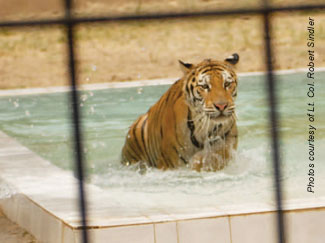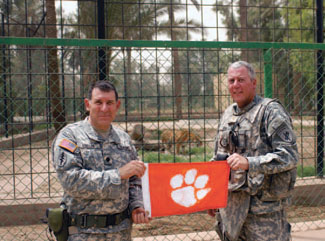Two tigers seen as signs of recovery in Iraq
Gun trucks escorted the tigers Hope and Riley as they left Baghdad International Airport.
"Since you have to go into the 'red zone' to get to the Baghdad Zoo, we had to convoy and go in full protective armor and take gun trucks with us, the whole works," said Maj. Freddie Zink, a U.S. Army veterinarian. "It was not a simple mission."
The drive went smoothly, and the tigers arrived within 45 minutes of leaving the airport, Maj. Zink said. Handlers kept ice on top of wood on the animals' cages to keep them cool, he said.
The Siberian-Bengal mix tigers seemed gentle, Maj. Zink said. "You wanted to reach in there and pet them, but you knew better."


Hope and Riley arrived in Baghdad Aug. 4 after lengthy travel from a North Carolina conservatory and much more lengthy efforts to acquire them. They are now shown off as proof of progress in the country, said Maj. Madonna Higgins, a U.S. Army veterinarian.
"There was tremendous coordination and effort on all sides moving these animals as safe and efficiently as possible," Maj. Higgins said in a message.
From North Carolina to Baghdad
The U.S. Department of State and U.S. military had been trying to replace the Baghdad Zoo's only tiger since it was killed in 2004, Maj. Zink said.
The people at the zoo were asked all along, 'What's the number one animal you would like to have in the zoo?'" Maj. Zink said. "And nothing but 'a tiger' was ever given as an answer.
— MAJ. FREDDIE ZINK, A U.S. ARMY VETERINARIAN
Lt. Col. Robert Sindler, another U.S. Army veterinarian, said groups tried to bring tigers to the zoo for the past five years. One group couldn't get the appropriate permits, while others' efforts stopped after their tours of duty ended.
The lieutenant colonel led the seven-month project to acquire Hope and Riley, even extending his time in Iraq by a month to finish the endeavor. He watched as they were unloaded at the airport.
"They just really looked good," Lt. Col. Sindler said, adding that it occurred to him at that point the tigers were actually going to arrive at the zoo.
The zoo suffered from looting after Saddam Hussein's government fell, according to information from the U.S. Embassy in Baghdad. Some animals roamed the park freely in the first months after the invasion in 2003, Maj. Higgins said.
The facility's previous tiger died after it attacked a U.S. soldier and another soldier shot it, Lt. Col. Sindler said. The tiger was in its enclosure, but one of the men was close enough for the tiger to reach.
Rod Hackney, spokesman for North Carolina Zoo, said his zoo led efforts by the Association of Zoos and Aquariums to secure and reconstruct the Baghdad Zoo. The association raised about $300,000 and brought in advisers to help rebuild and refurbish the facility for the few animals that remained.
Mindy Stinner, one of the founders of the Mebane, N.C.-based Conservators' Center, said her facility provided Hope and Riley to the zoo, but not until several years after hearing the U.S. government's proposal. She worried about security in the event of U.S. withdrawal from Iraq, consistency of the zoo's food supply, training for zookeepers, and continuing education and pharmaceutical access for zoo veterinarians, she said.
Initially, the center didn't have any cats Stinner thought would fit well with the proposal.
Zoo officials since arranged for a steady food supply and a backup food source, Stinner said. Zoo keepers went to the United Kingdom for training, and veterinary staff used telecommunication equipment to take classes from North Carolina State University.
As of early August, 14 Baghdad Zoo veterinarians continued work with coalition forces and international educational institutions, according to information from the embassy. Two were expected to receive advanced exotic animal care training in the U.K.
And Stinner said she saw photos of the tiger enclosure and heard assessments from three U.S. veterinarians in Iraq. Maj. Zink said the tigers' enclosure is functional, clean, and big.
Maj. Zink said, "Some of the metal may have some paint chipping off, there are not pretty bushes all around the enclosure, and it's not fancy like in the United States, but it's 100 percent practical and 100 percent safe and clean."
Maj. Zink said the tigers, on release from their cages, quickly found a place to play. "Within 15 minutes, 20 minutes, they were in their swimming pool playing."
Big cats, big hit
Stinner said she wanted to send young, good-looking, active cats that would adapt well to the people and climate. Center staff began looking in February for a pair to send, and they found Hope and Riley at a Charlotte, N.C., facility that had recently been sold and downsized.
Hope was bouncy, and Riley seemed laid-back; both were playful, Stinner said. "We knew that they would be a big hit."
Hope was about 18 months old and weighed about 200 pounds when she left the U.S. in early August. Riley is three months younger and was about 225 pounds.
"Hope is probably going to be in the 350- to 400-pound range," Stinner said. "I don't think she's going to be especially enormous.
"Riley—I'd be surprised if he stops before 500 pounds."
Lt. Col. Sindler said the tigers were among the friendliest he has seen, and it was apparent they were accustomed to people.
Flying to Baghdad
Stinner said she and Conservators' Center co-founder Douglas Evans drove the tigers to John F. Kennedy International Airport in New York, where they were loaded onto a DHL airplane to Brussels.
"It's very hard to get anybody to put tigers on a plane," Stinner said, jokingly adding, "You know, for some reason people have concerns about that."
Stinner and Evans spent about 19 hours in the air while flying with the tigers to Brussels, Belgium, and then Bahrain. The tigers slept most of the way.
Maj. Higgins, one of the military veterinarians who took control of the tigers in Bahrain, said the U.S. Embassy paid the $66,000 to bring the tigers to the zoo, which is patrolled by U.S. and Iraqi soldiers.
A few hundred people were at the Baghdad Zoo when U.S. soldiers delivered the tigers. Maj. Zink said the zoo is considered a safe place to relax and talk, although it is in an area where soldiers are advised to wear body armor, mostly as a matter of protocol.
The zoo has other large animals, including lions and bears, the latter of which are native to northern Iraq, Lt. Col. Sindler said. Iraqis take pride in the zoo, and he feels good about adding Hope and Riley.
"It builds a lot of friendship and good will between really the U.S. and the Iraqi people," the lieutenant colonel said.
The tigers are on permanent loan from the Conservators' Center, a provision to ensure they would be returned if the Baghdad Zoo couldn't keep them for any reason. Stinner plans to send care packages to Baghdad every quarter to give the tigers items such as toys, vitamins, and scents they enjoy.